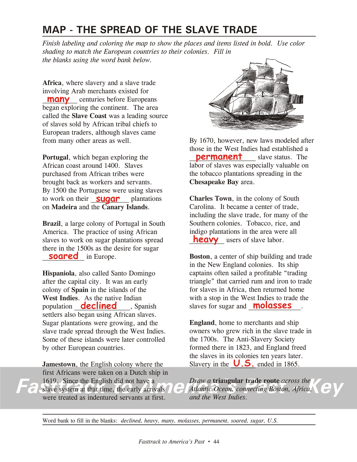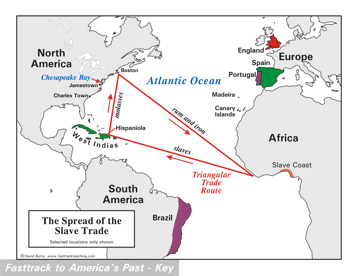| Fasttrack
to America's Past Teacher Key |
|
| Fasttrack
to America's Past Teacher Key |
|
 Page 44  Page 45 The map is shown
as it appears when completed by students using color
pencils. The
full size map that students will use to guide their work can be found
with the link on the main index page for this section.
Please read the "Tips for completing the map" in the next column. |
Pages 44
& 45 - Map - The Spread of the Slave Trade Map guide, page 44 Students should use the word bank at the bottom of the page as they work to complete the map guide's "fill in the blank" sentences. Africa - ...for many centuries... Portugal - ...their sugar plantations... Brazil - ...sugar soared in... Hispaniola - ...population declined... Jamestown - ...a permanent slave... Charles Town - ...all heavy users... Boston - ...sugar and molasses. England - ...in the U.S. ended... The picture The drawing shows a sailing ship of the size typically used for transatlantic shipping. Conditions on board for the captured slaves were horrific, and many died during the voyage. Tips for completing the map, page 45 Students should
work from the full size, completed map page shown with the link from
this
section's main
index page.
Emphasize neatness from the beginning! Students should complete this map as they
work on the facing
page. Have students read the first paragraph aloud, decide
together
on the right answer for the blank, then locate and shade the area of
the
Slave Coast with an orange color pencil. |
|
Copyright Notice
Copyright 2018 by David Burns. All rights reserved. Illustrations and reading selections appearing in this work are taken from sources in the public domain and from private collections used by permission. Sources include: the Dover Pictorial Archive, the Library of Congress, The National Archives, The Hart Publishing Co., Corel Corporation and its licensors, Nova Development Corporation and its licensors, and others. Maps were created or adapted by the author using reference maps from the United States Geological Survey and Cartesia Software. Please see the home page for this title for more information. |